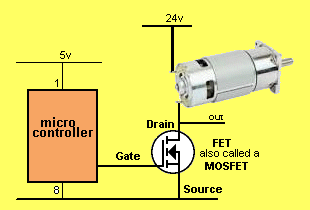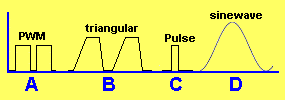A transistor can be used as an analogue device or a DIGITAL device. It has been covered as an analogue device in audio amplifiers all over the web and in text books. But its main use in recent times has been as a digital device. In other words we are talking about its use in DIGITAL CIRCUITS where it is either ON or OFF and is consuming little or no current. This mode of operation has taken over electronics designs because the two states have fixed and rigid values. There is no "half-on" or "one quarter off." And because it is either ON or OFF, the condition is 100% reliable, predictable and copyable. When we talk about this mode of operation, we also find there is a better component than the ordinary transistor. It is called the Field Effect Transistor (FET) because it has a characteristic of having a very small voltage across it when a large current flows. A common transistor has a voltage of about 0.3v to 0.8v or more across the collector-emitter terminals and even though this voltage is very small, when a high current flows, the transistor will get very hot. If we replace it with a FET, the device stays cool or even cold. The voltage across it will be only a few millivolts to a few hundred millivolts. This is a great advantage as no heat-fin may be needed. But it is important to drive both devices with a what we say is a high amplitude signal. This is especially needed for a FET as the gate needs a few volts for it to operate and a slightly higher voltage to make sure it is turned ON. An ordinary transistor needs just 0.7v. When we have a high amplitude signal, a digital-design can be easily converted to a FET design. All you have to know is the base of an ordinary transistor is now the gate of a FET and the input voltage needs to be more than about 2.5v. I say "about" because the family of FETs has a wide range of gate voltages and you need to refer to a specification-sheet for the exact value. Here is the circuit for a common-emitter stage and a common-source stage:
Provided the common transistor has a base resistor to prevent the base being pulled higher than 0.7v, either device will work in the project you are designing.
In a Digital Stage, the input waveform can be any amplitude and any
shape - with exceptions, as mentioned below. When we say the "rise time" is too long, we mean the time taken for the signal to rise from point A to point B: And this applies to the full amplitude of the signal.
Transistors are limited
to a gain of about 100 when powering a motor from a microcontroller. |
Try this test and see if you get 100%.
We are using a simple NPN transistor such as BC547, BC557 or BC338 and a small
to medium current MOSFET.
Not all the answers have been covered in the lecture-notes above.
The Test is to see how much you know.
1. Name the three leads of a common transistor:
Collector Bias Omitter
Base Collector Case
Collector Base Emitter
Emitter Collector Bias
2. Name the three leads of a MOSFET:
collector base emitter
grid drain source
grid base source
grid base drain
3. Identify the correct labelling:

A
B
C
D
4. The voltage on the gate must be:
100millivolts
0.7v
1.5v or more
any voltage
5. What is the gate voltage:

0v
5v
24v
unknown
6. What is the current supplied to the gate in the circuit above:
25mA
20mA
5mA
less than 1mA
Note: The microcontroller can supply up to 25mA but the gate is a capacitor
with a very small capacitance and the current delivered is much less than 1mA as
the gate is not a resistance.
7. Identify the types of suitable input waveforms:

B and C
B and D
A and C
A and B
8. If the voltage on the gate increases, does the MOSFET turn ON harder:
No
Yes
Remains the same
Note: The voltage on the gate has an effect on the drain-source resistance
and it turns ON harder when the voltage is increased.
9. You have a microcontroller and a 24v motor that takes 10amps. Would
you use a transistor driver or MOSFET:
MOSFET
Transistor
direct
connection
Note: The output of the microcontroller is 5v and 25mA max. A
transistor cannot interface 25mA and 10 amps. You need to use a MOSFET
10. From the data above, what will be the approx dissipation in the MOSFET:
70 watts
700milliwatts
7 watts
0.7 watts
Note: The heat generated in the MOSFET will be something like
10 x 10 x 0.07 = 7watts The losses increase "as the square of the
current."
Contact Colin
Mitchell if you want any help Go to
Talking Electronics
website
Now go to these links:
Link 1 & Link for Capacitor understanding
Link 2
Link 3
and then 200 Transistor Circuits, to get some ideas on how to use the transistor.
9-4-2024







